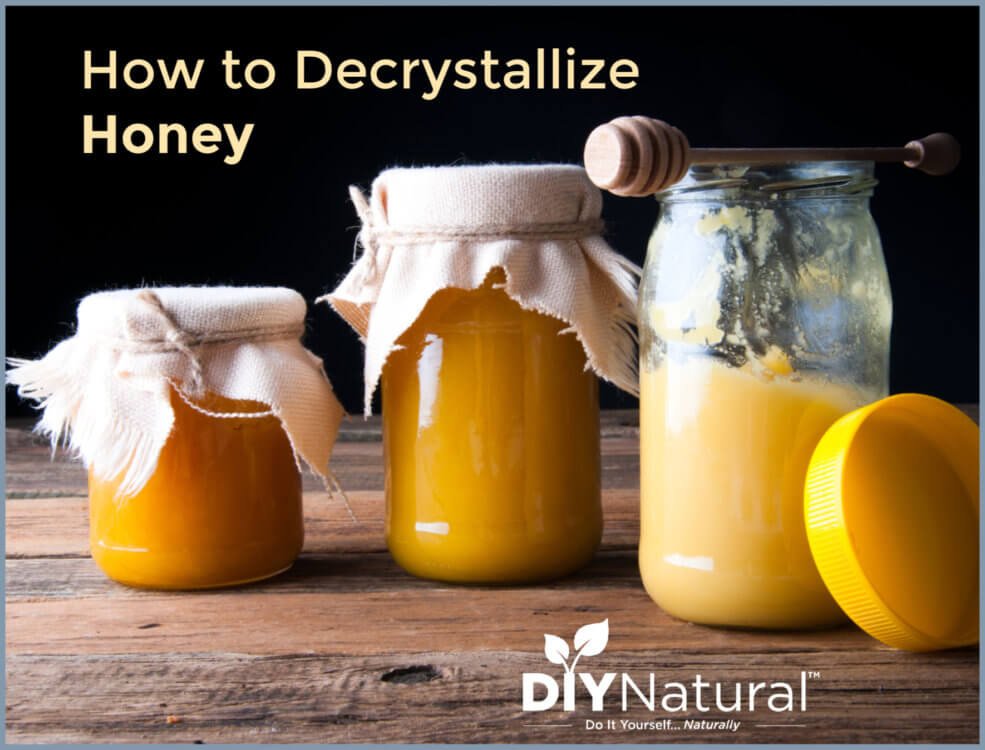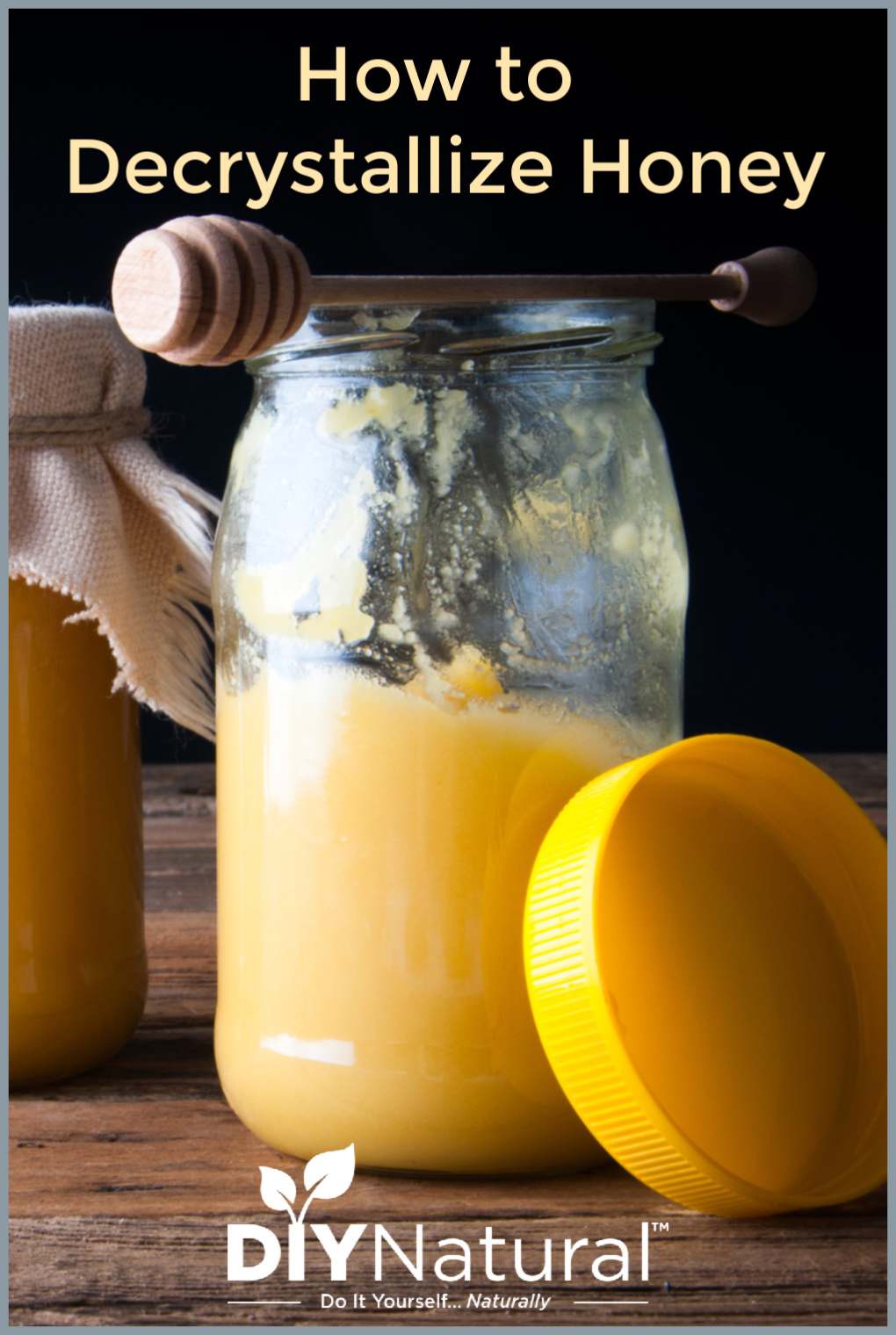
There are several reasons why honey may crystallize. Let’s talk about those reasons and then learn how to decrystallize honey in several different ways.
I have to admit that I’m a bit of a honey snob. I have a few local places that I get my honey on a regular basis, but if I’m out and about, like say, in Gatlinburg, I’ll pick up a jar, just for fun. And sometimes I forget them in the back of the cupboard. Pulling it out, I realize that it has crystallized. Don’t worry, I’ve got a solution for that.
Why Does Honey Crystallize?
There are several reasons why honey may crystallize. Let’s take a look at them then talk about how to decrystallize our honey.
Water in The Honey
I have this problem at the coffee shop I run. I clean the honey bottle, but I can’t always wait for it to dry, so I’ll pour the honey in any way, hoping for the best. It usually gets used pretty fast, but sometimes not fast enough and crystals start to form.
Climate
Some say it has nothing to do with actual water in the honey as it’s nectar that the bees bring back to the hive. But in drier climates or years with less rainfall, honey will tend to crystallize more.
Impurities in The Honey
If there’s a piece of honeycomb, pollen or other debris, honey can start to crystallize around it. Honey that you buy in the store is usually filtered well, giving it much longer shelf life.
Cold Honey
If it gets below 50 where you are, honey can start to crystallize at lower temperatures. Storing it in the kitchen, rather than the basement should help keep the honey decrystallized.
Type of Honey
Some types of honey are more likely to crystallize, such as alfalfa or clover. Because there may be more moisture? Less moisture? No one really knows for sure.
Age of The Honey
Honey will naturally crystallize on its own after a time. If your honey is older, it’s a sure bet that crystals will form.
No matter how the honey crystallized or why you can bring it back with a few simple steps.
How to Decrystallize Honey
The most common way to decrystallize honey is heat. Here are a few methods that have worked well for me:
Hot Water
Use a nonreactive pan like stainless steel. It should be as tall as the honey in the jar. Place the closed jar of honey in the pan and fill the pan with hot water up to where the honey is in the jar. Wait until the water is cool. Lift the jar out of the pan of water and stir. If there are still crystals in the honey, repeat the process. When the honey is liquid, use as you normally would.
In The Oven
Place the open jar of honey in a pan at a lower temperature, like 200°f. Leave for 30 minutes or so. Stir and repeat if necessary to decrystallize the honey completely.
In A Slow Cooker
Place open jars of honey in your slow cooker and leave on low for 8 hours or so. No water is necessary, you can do this dry. Leave the honey in the slow cooker for longer if there are still honey crystals present.
Don’t Microwave Crystallized Honey
Don’t be tempted to use a microwave. While they are good for some things, honey is very dense and can create hot spots. When honey is heated too much, you can kill beneficial bacteria. You’ll still have good tasting honey but won’t get the health benefits from the good bacteria.
How Long Will Honey Stay Decrystallized?
Something to remember is that once you liquefy your honey, it will usually only stay liquid for a short time. Unless you plan to use it soon, it may recrystallize again. Luckily, there’s no limit to how many times you can decrystallize honey.
Other Ideas
If you find your honey crystallizes fast no matter what you do-roll with it! Crystallized honey is safe to eat just the way it is. You can whip it and use it as creamed honey. A local place here in Western North Carolina sells cinnamon, lemon, and even cayenne creamed honey. Or you could use it as is. There is nothing wrong with using crystallized honey. It melts in your tea just like a liquid honey will. But if you see mold in your honey when you open it, toss it right away. Something has gone wrong somewhere as honey doesn’t usually support mold activity. It could be impure or could have had a substance introduced to it that caused the mold.
Do you know how to decrystallize honey another way? Share it with us.
*******




Love the dehydrator idea! I invested in a good digital dehydrator, when I started making my own kratom extract to replace the pain medication I could no longer get. It makes it easy to ensure my extracts never get hot enough to destroy the useful alkaloids, so why wouldn’t it work for preserving the health benefits of raw honey?! In fact, I was trying to figure out how to make a raw cacao sauce or syrup, without breaking down the good enzymes, and this sounds like a perfect way to do both at the same time. The longer I have my dehydrator, the more good uses I find for it. Now, I’m inspired to revisit many diy ideas that I keep putting off, due to temperature concerns and breaking down most of the healthy benefits of raw foods. A digital dehydrator might become my new favorite “cooking” tool.
Thanks for the tip about finding mold on honey! If I didn’t know any better, I probably would have just scraped it off! For decrystallizing, I have used the hot water method and it’s worked great.
At 90* and above, honey will begin to lose the healthy enzymes that make it so healthy for us. I wouldn’t heat it any higher than that.
NOTE: crock pots (more accurate is slow cooker, as mentioned in the article) heat on both low and high to the exact same temperature, 285*, I believe. I contacted a manufacturer and they said that both low and high settings would get to that temperature, with the low setting taking longer to get to it. I would NOT recommend using a slow cooker to de-crystalize honey for that reason. IF you can adjust the temperature on your dehydrator down to 90*, that would be ok. I believe that the hot water method is the safest in order to not destroy the healthy enzymes.
I actually like some of my honey to crystalize. I use that honey as a facial scrub, without having to add anything to give the ‘roughage’!
That’s an excellent idea, Danelle! And a good use for our Excalibur when not filled with herbs and flowers. Also, will help to better regulate the temperature of the honey than our usual method (pan of hot water on the stove–yikes!) Thanks!
We use our dehydrator (Excalibur!) to decrystalize the honey. A local beekeeper mentioned that the temperature of the hive is about 110 degrees, so we just set that temp on the dehydrator.
That’s an excellent idea, Danelle! And a good use for our Excalibur when not filled with herbs and flowers. Also, will help to better regulate the temperature of the honey than our usual method (pan of hot water on the stove–yikes!) Thanks!
How do you put a jar of honey in a dehydrator?
Well, the Excalibur is a giant box with removable shelves. Mine will hold a gallon container on its side.
It is important to note that the set temperature of 110F is NOT the actual temp of the food inside. However this setting does accomplish the goal. Larger quantities will take longer to decrystalize…a gallon may take a few days.